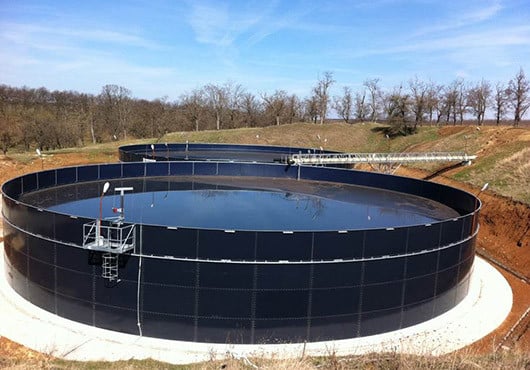This article describes the integration of the N2 Applied technology, and the different components consisting of a separator, buffer tank, the N2 Unit, NEO storage tank, heat recovery and power supply. The process utilises nitrogen from air, injects it in the liquid fraction of separated livestock slurry, and thereby creates a nutrient-rich, low emission fertiliser product (NEO) which can be spread on crops. To obtain this result, slurry and electricity need to be available at, or nearby the area where the container is placed.
Barn and slurry storage
In connection with the barn, there is normally a buffer capacity in the channel mixing / manure storage, and a slurry pit or similar is where the N2 process will start integrating. As emissions from manure in the form of methane and ammonia occurs straight from the cow, it may be of interest to make the retention time low in the untreated storage, as the N2 Applied process stops ammonia and methane emissions as well as odour. Filtering the slurry (solid and liquid separation) is required to meet the specifications of the N2 Unit. The specification are < 3mm particle size and < 6% dry matter content.
Separation
Manure from cattle or pigs will mostly contain water. However, there are also some dry particles that are commonly left over solids from either bedding materials or undigested feeds. There are numerous ways of separating manure and several solutions are available on the market, ranging from low-cost products on the web, to higher cost solutions from reputable producers. For this purpose, a simple plug-and-play solution with automated operation will be advantageous.
The dry matter can be used for composting, soil improvement and spreading, while the liquid fraction goes into a buffer tank before the N2 Unit. Green bedding could also be an alternative usage for the solid fraction, but this requires a high-quality separator, able to work with high pressure.
Liquid buffer tank
A buffer tank for the liquid slurry should be placed in proximity of the N2 Unit, as this is where the N2 Unit draw from. The size of the buffer tank can be flexible, the aim is to keep the retention time at a moderate level and ensure continuous flow to the N2 Unit. Thus, the slurry buffer tank should cover a processing period of a couple of days or longer if possible. This makes the size needed in the area of 10 to 45 m3.
N2 production Unit
The N2 Unit only needs air and electricity to operate and an internet connection for remote monitoring and support. The N2 Unit draws livestock slurry from the buffer tank, initiated and controlled by the integrated N2 control system. The N2 Unit will normally be placed inside a standard 20 ft container. The placement of the container on farm is important, both for economic and operational reasons. The container should be placed on a hard flat surface. Additionally, both electricity and livestock slurry are to be delivered to the container and a transport vehicle must have access to the site.
Outfeed from the N2 process is then routed to the final storage tank. The N2 Unit requires a 400V / 100A 3-phase power supply and a 125A socket on the wall near the N2 Unit is recommended.
NEO storage tank
When the liquid slurry has been treated in the N2 process, NEO is produced and pumped in to the storage tank. NEO should not be mixed with storage of untreated livestock slurry, therefore if using an existing storage tank or lagoon, this should be cleaned or re-lined. Sufficient capacity is recommended to hold the slurry produced on the farm. Thus, the size of the storage required depends on the volume and the time NEO has to be stored before being spread on the field, meeting the necessary regulation of your area.

Heat recovery
During production, the N2 process creates excess heat, which can be utilised for improving total energy balance. This heat can be captured as hot water with a temperature up to 60 degrees C. If desired, a separate circuit can be established for this hot water, using an insulated pipe or hose to transport the heat to the desired location. Alternatively, for direct heating, the heat exchanger fan can be placed inside a barn or other area that requires heat. Alternatively, if heat isn't required elsewere, the excess heat will be cooled from the integrated heat exchanger on the roof of the N2 container.


